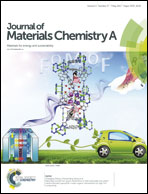Novel thin-film composite membranes via manipulating the synergistic interaction of dopamine and m-phenylenediamine for highly efficient forward osmosis desalination†
Abstract
Novel thin-film composite (TFC) membranes were elaborately designed and fabricated via the incorporation of mussel-inspired dopamine (DA) into an m-phenylendiamine (MPD) aqueous solution followed by interfacial polymerization with trimesoyl chloride (TMC) on a macroporous substrate. This DA-incorporation strategy was distinct from the previous DA layer serving as a hydrophilicity–promoter or reactive intermedia. The elastic structure of the polyamide (PA) layer and the hydrophilicity of both the PA layer and substrate were in situ flexibly manipulated by regulating the DA/MPD mass ratio and solution pH. The optimized TMC/MPD–DA TFC membranes achieved a significantly enhanced water flux (50 L m−2 h−1, improved 3-fold compared to the conventional TMC/MPD membrane) and a comparable reverse salt flux of 8.19 g m−2 h−1 for forward osmosis (FO) using deionized water as the feed along with 1 M NaCl draw solution in the FO mode. It also yielded a superior water permeability (A) of 1.8 L per m2 per h per bar compared to the TMC/MPD membrane (1.0 L per m2 per h per bar) while maintaining a NaCl rejection of over 92% at 2 bar. The proposed synergistic interaction between DA and MPD in aqueous solution responding to the solution pH played a crucial role in controlling the interfacial polymerization process. Michael addition and Schiff base reaction between PDA and MPD at a proper pH (8.5) could weaken both the residual DA monomer and the PDA aggregate generation, facilitating the establishment of a defect-free and uniform PA layer with a proper cross-linking degree to enhance the water transport. This DA-incorporation strategy for the TFC membrane demonstrated here sheds light on the exploration of high water transport for highly efficient FO and other desalination processes.



 Please wait while we load your content...
Please wait while we load your content...